It's Hoopfest, Man
What keeps a 43-year-old playing competitive basketball?
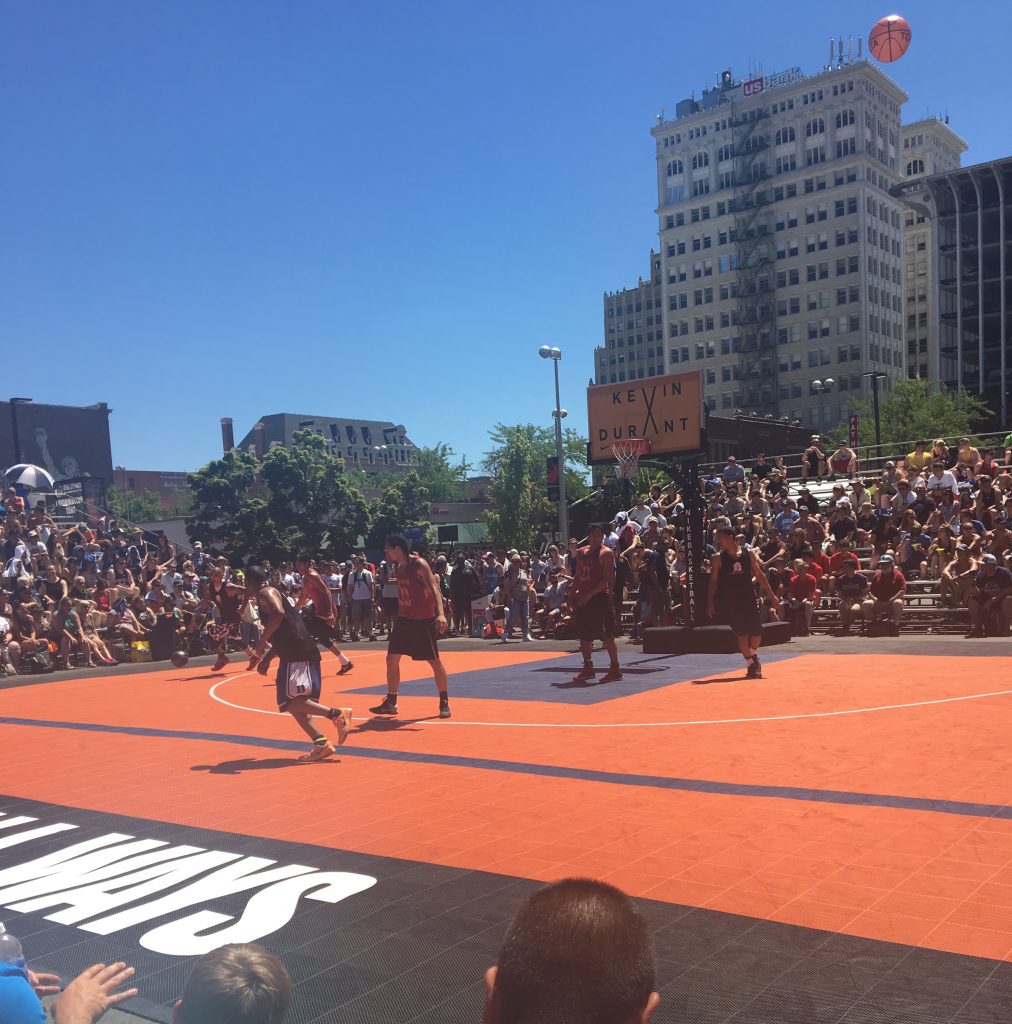
At dawn, Henry Williams Camel, Jr., left the Flathead Reservation in Montana and headed west on I-90, weaving through the Rockies as the sun began to rise in his rearview. In the late ‘90s, when Camel, who goes by JR, starred as one of the earliest Native Americans to play Division 1 basketball, the interstate had a speed limit of “reasonable and prudent.” Today, the limit is 80 miles per hour, and Camel had to be in Spokane, Washington (209 miles from the reservation) by 8:00 a.m. to register for the world’s biggest outdoor 3-on-3 basketball tournament: the Spokane Hoopfest.
Camel, who is 43 years old, is his team’s best player, and one of the top players at Hoopfest every year. His team, Desert Horse Elite, had won the championship for the 6-Foot-and-Under Elite Division three years in a row, and if they won again this year, they’d become just the third team in the Hoopfest’s 28-year history to win four straight. I was less interested in if Desert Horse was going to win this year than I was in why Camel would keep playing basketball at the highest level against players half his age, long after he seemingly had anything left to play for, on unforgiving asphalt in 90-degree heat, when the stakes were only what you made them and the reward was a T-shirt, some Nike gear and a blurb in the local newspaper.
![]()
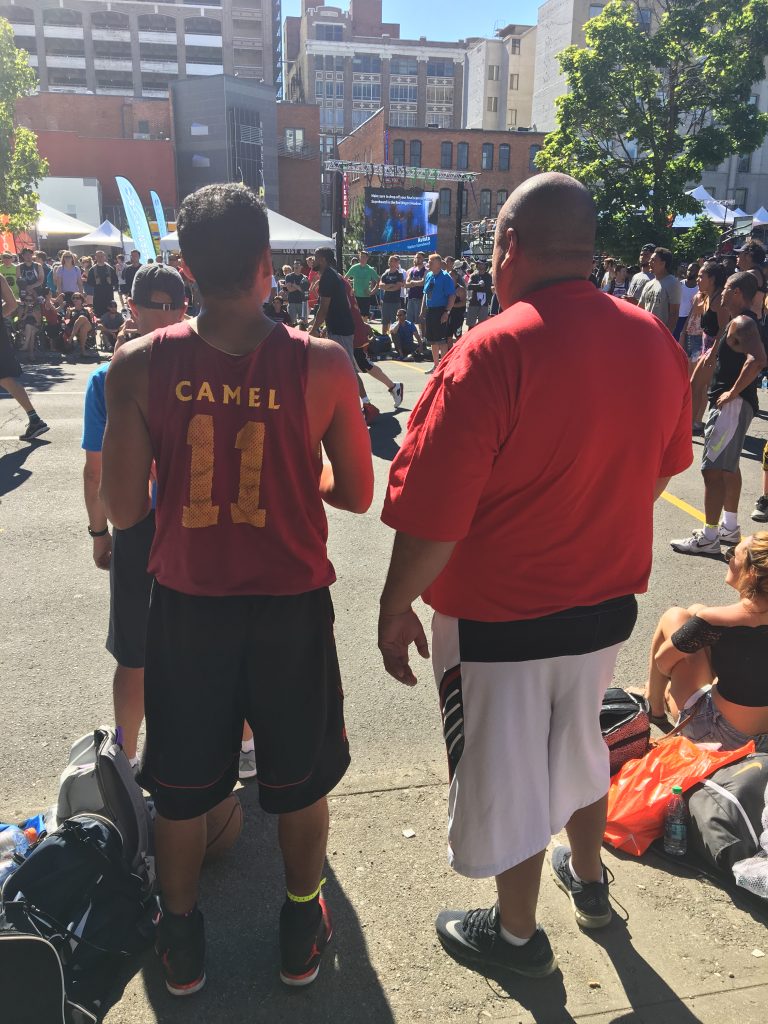 Camel is six feet tall, but his broad, sinewed shoulders give the impression that he’s half a foot taller. Aside from a few deep creases stretching across his brow and wrinkles creeping under his eyes, he still looks a lot like the player who was named Montana’s Mr. Basketball in high school, and later starred at the University of Montana and played pro overseas. Out west, he’s mentioned in the same breath as legendary Montana players like Jonathan Takes Enemy and Elvis Oldbull, whom he grew up idolizing and later competing against. “I played against them, beat them all” he told me. In December, Camel was inducted into the Montana Indian Athletic Hall of Fame, and a Montana sports affiliate had recently made a list of the top all-time high school basketball players in the state’s history, ranking Camel 16th.
Camel is six feet tall, but his broad, sinewed shoulders give the impression that he’s half a foot taller. Aside from a few deep creases stretching across his brow and wrinkles creeping under his eyes, he still looks a lot like the player who was named Montana’s Mr. Basketball in high school, and later starred at the University of Montana and played pro overseas. Out west, he’s mentioned in the same breath as legendary Montana players like Jonathan Takes Enemy and Elvis Oldbull, whom he grew up idolizing and later competing against. “I played against them, beat them all” he told me. In December, Camel was inducted into the Montana Indian Athletic Hall of Fame, and a Montana sports affiliate had recently made a list of the top all-time high school basketball players in the state’s history, ranking Camel 16th.
Camel, his brother, Zack, 49, and his 22-year-old nephew, Zachary, are members of the confederated Salish and Kootenai tribes, and the rest of Desert Horse’s players represent the Spokane Tribe, the Warm Springs reservation and the Northern Cheyenne. JR and Zack were both quick to tell me that no one on Desert Horse drinks or does drugs. “A lot of reservations there’s nothing there, there’s no dogs, there’s just nothing other than us Indians,” Zack said.
The rest of the Desert Horse team had arrived in Spokane the night before the tournament and gotten a full night’s sleep, but Camel preferred to make the drive early drive Saturday. “I’ve won it the last three years doing it this way,” he said. “And I’m a little superstitious, so I just thought, I’m going to do it the same way.” In the back of his minivan, he had a mattress, where he planned to rest between games—when the weekend temperatures were projected to hit the mid-90s and players and spectators clustered under the canopy trees lining the sidewalks, trying escape the beating sun in Spokane’s cloudless sky. He pulled into Spokane with 30 minutes to spare.![]() Every year, in the last weekend of June, Spokane closes its downtown streets to traffic and erects more than 400 hoops across 45 city blocks. In Riverfront Park, along the Spokane River, vendors inflate bouncy castles and set up food stands hawking county fair grub like grilled mac and cheese, deep-fried ribs, and hot dogs wrapped in bacon or stuffed with cream cheese. This year, an estimated quarter of a million people attended, including 23,328 players on 5,937 teams. While most games were played on the street, the best teams, like Desert Horse, would occasionally be featured on a Nike-sponsored court, which was surrounded by sturdy wooden bleachers and a press booth shaded by a white awning. Next to the court, under a long tent, a makeshift Nike store sold t-shirts and memorabilia; a Hoopfest basketball cost $45.
Every year, in the last weekend of June, Spokane closes its downtown streets to traffic and erects more than 400 hoops across 45 city blocks. In Riverfront Park, along the Spokane River, vendors inflate bouncy castles and set up food stands hawking county fair grub like grilled mac and cheese, deep-fried ribs, and hot dogs wrapped in bacon or stuffed with cream cheese. This year, an estimated quarter of a million people attended, including 23,328 players on 5,937 teams. While most games were played on the street, the best teams, like Desert Horse, would occasionally be featured on a Nike-sponsored court, which was surrounded by sturdy wooden bleachers and a press booth shaded by a white awning. Next to the court, under a long tent, a makeshift Nike store sold t-shirts and memorabilia; a Hoopfest basketball cost $45.
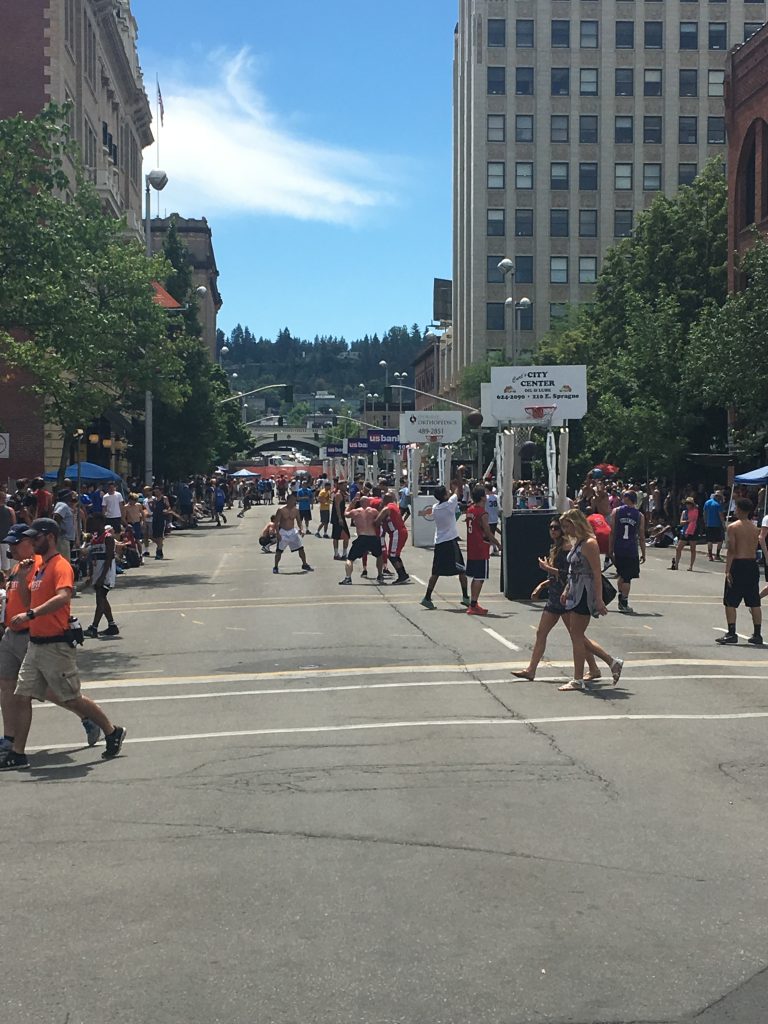
That morning, Camel made his way over to the registration booth, where his height was officially measured, down to the half-inch, to ensure he belonged in the 6-Foot-and-Under division (there are some rare attempts at cheating at Hoopfest—I saw a 31-year-old player get caught trying to register in the 40-and-over division). Then he moved to one of the street courts to begin scouting Desert Horse’s potential opponents for the day.
The essence of basketball is so often reduced to the cliche of “poetry in motion,” which fails to capture the game’s underlying meanness. Its physicality is magnified in 3-on-3 street basketball, where games are played on only half a court, up to 20 points or for 25 minutes (whichever comes first), and fans pack in close to the boundary lines. The congested basketball I watched at Hoopfest looked far from graceful, or fun. It was fucking brutal: players rarely broke free for uncontested jump-shots or blew past their opponents for wide-open layups. Points had to be manufactured seemingly out of sheer will. The only way a player could create enough space to get a shot off was to barrel toward the hoop, and slam his shoulders into his defender’s chest, knocking them off balance just long enough to throw up a prayer at the basket.
Occasionally, players would knock down long two-point shots (at Hoopfest, there are no three-pointers, only twos and ones), but the sloped streets made this difficult. For the most part, if a shot didn’t swish through the net, it ricocheted off the backboard or missed the rim entirely. If a player was fortunate enough to snag a rebound after a missed shot, he was rewarded with a gauntlet of elbows to the ribs while hands swiped at the ball. Over the loudspeakers, the Hoopfest MC reminded everyone that it was recommended we drink at least a dozen bottles of water over the course of the day.![]() Desert Horse started their first game sluggish, missing their first couple of shots badly. The only player who seemed to be in rhythm was JR Camel, who eventually scored Desert Horse’s first point. After he scored, the MC extolled, “JR Camel doin’ what he does best, just working, working, working.” In college, Camel was relentless, slicing to the hoop and frequently punishing the rim with aggressive dunks (as a senior in high school, he averaged three dunks per game). Now, his game is more methodical. He favored catching the ball on the right side, about ten feet from the hoop, taking four or five dribbles, and either waiting for one of his teammates’ defenders to double-team him so he could pass the ball out for an open shot or, if the double-team didn’t come, slamming into his defender and tossing up a soft layup off the backboard. This move often baited his defender into fouling him in the process. Preston Wynne, a longtime teammate of Camel’s, revered his style of play. “I’ve played against a few NBA players and I don’t know how this guy never was in the NBA,” Wynne told me. “It makes no sense to me … He’s 43 years old and he’s still out there playing against these people…making them look like JV high school players.” Wynne, who’s 30 and plays professionally overseas, was watching from the sidelines because he was still recovering from a stress fracture in his leg, suffered last year, a week before Hoopfest.
Desert Horse started their first game sluggish, missing their first couple of shots badly. The only player who seemed to be in rhythm was JR Camel, who eventually scored Desert Horse’s first point. After he scored, the MC extolled, “JR Camel doin’ what he does best, just working, working, working.” In college, Camel was relentless, slicing to the hoop and frequently punishing the rim with aggressive dunks (as a senior in high school, he averaged three dunks per game). Now, his game is more methodical. He favored catching the ball on the right side, about ten feet from the hoop, taking four or five dribbles, and either waiting for one of his teammates’ defenders to double-team him so he could pass the ball out for an open shot or, if the double-team didn’t come, slamming into his defender and tossing up a soft layup off the backboard. This move often baited his defender into fouling him in the process. Preston Wynne, a longtime teammate of Camel’s, revered his style of play. “I’ve played against a few NBA players and I don’t know how this guy never was in the NBA,” Wynne told me. “It makes no sense to me … He’s 43 years old and he’s still out there playing against these people…making them look like JV high school players.” Wynne, who’s 30 and plays professionally overseas, was watching from the sidelines because he was still recovering from a stress fracture in his leg, suffered last year, a week before Hoopfest.
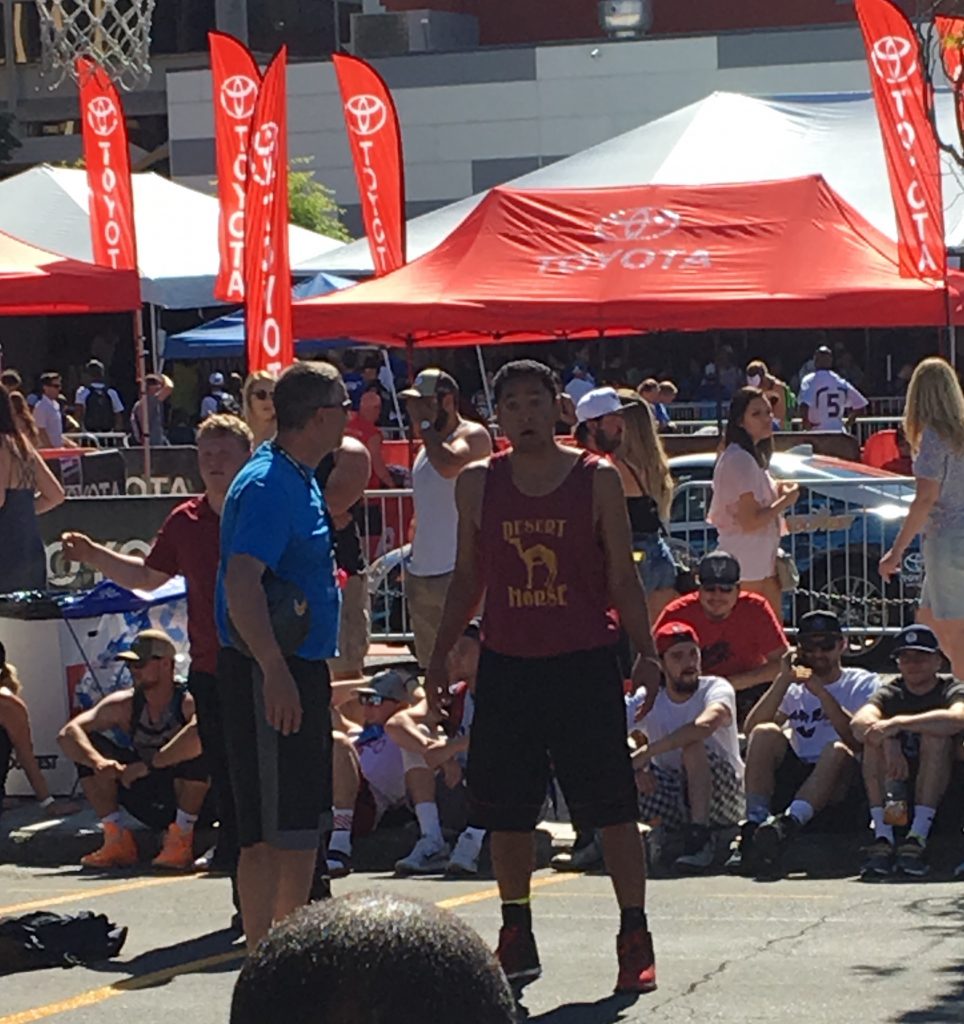
At first, I had trouble seeing what Wynne and others were marveling at. Camel’s game wasn’t glamorous—he didn’t have the passing wizardry of Pistol Pete or Magic Johnson or the effortless shooting stroke of Steph Curry. But the longer I watched, the more I noticed how crafty Camel was. He used his hips to knock a teammates’ defender off balance as he ran by, which gave his teammate the extra half-second he needed to get his shot off, and on defense, he poked and prodded at the ball, frequently stealing it when his opponent got careless. The most stunning play I saw him make all weekend happened when a shot clanged hard off the rim, sending the ball high in the air and on the verge of soaring out of bounds. Both Camel and his opponent moved into position to snag it out of the air, but Camel, sensing he wouldn’t be able to get to the ball in time, allowed his man to jump for the ball uncontested. While his man was in mid-air, Camel shuffled over half a foot, so that his opponent wouldn’t have any space to land inbounds after securing the rebound. Sure enough, after the opposing player grabbed the ball in midair, he landed out of bounds, and Desert Horse was awarded possession.
A Hoopfest referee who’d been officiating Desert Horse’s games for the last ten years told me, “In truth, JR’s lost a step. He’s in his 40s, he’s slower than a couple of years ago.” He said Camel can be hard to officiate because as he’s gotten older he tries to compensate for diminishing footspeed by using his hands more on defense, and is therefore more likely to commit a foul. “I would say,” the ref added, “JR at his peak was probably the best street basketball player that I’ve seen in a long time.” Later, when Camel scored again to put Desert Horse up three points, the MC gushed, “Once again, JR Camel doing what he’s done what seems like about a million times here at Hoopfest. Backing guys down, scoring baskets.” After a slow start, Desert Horse won handedly.![]() Before Desert Horse’s next game, on one of the street courts, Camel stood under a canopy tree in a sliver of shade, talking with his brother, Zack, and occasionally stretching. Later, when I asked Zack why JR didn’t warm up before games, Zack chuckled. “He’s 43 years old, there aint nothin’ new that’s going to happen.” It was a spirited game. A thick crowd of fans gathered on the sidewalk and cheered for Desert Horse, hollering “Hey! Hey!” anytime Desert Horse’s opponents came close to stepping out of bounds. Whenever JR caught the ball in his favorite spot close to the hoop, someone in the crowd would yell, “Got a baby on him!” And when JR’s man seemed to shake loose for an open shot, JR sprinted out, leapt and tipped the ball with his fingertips, altering its flight and causing it to fall short of the hoop. “Gimme that shit!” he yelled. I overheard a kid standing nearby say, “JR’s my favorite.”
Before Desert Horse’s next game, on one of the street courts, Camel stood under a canopy tree in a sliver of shade, talking with his brother, Zack, and occasionally stretching. Later, when I asked Zack why JR didn’t warm up before games, Zack chuckled. “He’s 43 years old, there aint nothin’ new that’s going to happen.” It was a spirited game. A thick crowd of fans gathered on the sidewalk and cheered for Desert Horse, hollering “Hey! Hey!” anytime Desert Horse’s opponents came close to stepping out of bounds. Whenever JR caught the ball in his favorite spot close to the hoop, someone in the crowd would yell, “Got a baby on him!” And when JR’s man seemed to shake loose for an open shot, JR sprinted out, leapt and tipped the ball with his fingertips, altering its flight and causing it to fall short of the hoop. “Gimme that shit!” he yelled. I overheard a kid standing nearby say, “JR’s my favorite.”
After the final game of the day, I asked Camel flat out why he keeps playing. “I’m just trying to add to my legacy,” he said, matter-of-factly between sips of his sports drink. “I want to be remembered as one of the best, you know, even at my age of 43, you know, I still like battling with young guys and showing that I’m still one of the best.” He told me he was motivated by the courage of his daughter, who in the past year had been named all-state in track, basketball and volleyball. “She was a preemie, weighed one pound, 11 ounces, dude,” he said. “I held her in one hand.” He also said he found joy in playing against guys half his age. “I always tell people, seven more years, hopefully I can play when I’m 50. I’ll be playing against grandkids of people I played.” Hearing these motives for playing from professional athletes is commonplace, but hearing them from a man in his 40s who was doing it for free struck me as somehow off.![]() By late afternoon on Sunday, Desert Horse was prepping to play their third game of the day, against a team they had knocked out of the tournament each of the last five years. If they won, they’d move to the Nike Center court to defend their championship. Like they had all weekend, Desert Horse started off slow. I kept waiting for them to hit their stride. Soon they were down 18-11; if the other team scored a two-pointer, they would send Desert Horse home for good. Only now, with the game slipping away, did Desert Horse find a second burst, scoring seven points in a row to tie it up. If they could get just one more stop on defense and hit another two-pointer, they could squeak into the championship game.
By late afternoon on Sunday, Desert Horse was prepping to play their third game of the day, against a team they had knocked out of the tournament each of the last five years. If they won, they’d move to the Nike Center court to defend their championship. Like they had all weekend, Desert Horse started off slow. I kept waiting for them to hit their stride. Soon they were down 18-11; if the other team scored a two-pointer, they would send Desert Horse home for good. Only now, with the game slipping away, did Desert Horse find a second burst, scoring seven points in a row to tie it up. If they could get just one more stop on defense and hit another two-pointer, they could squeak into the championship game.
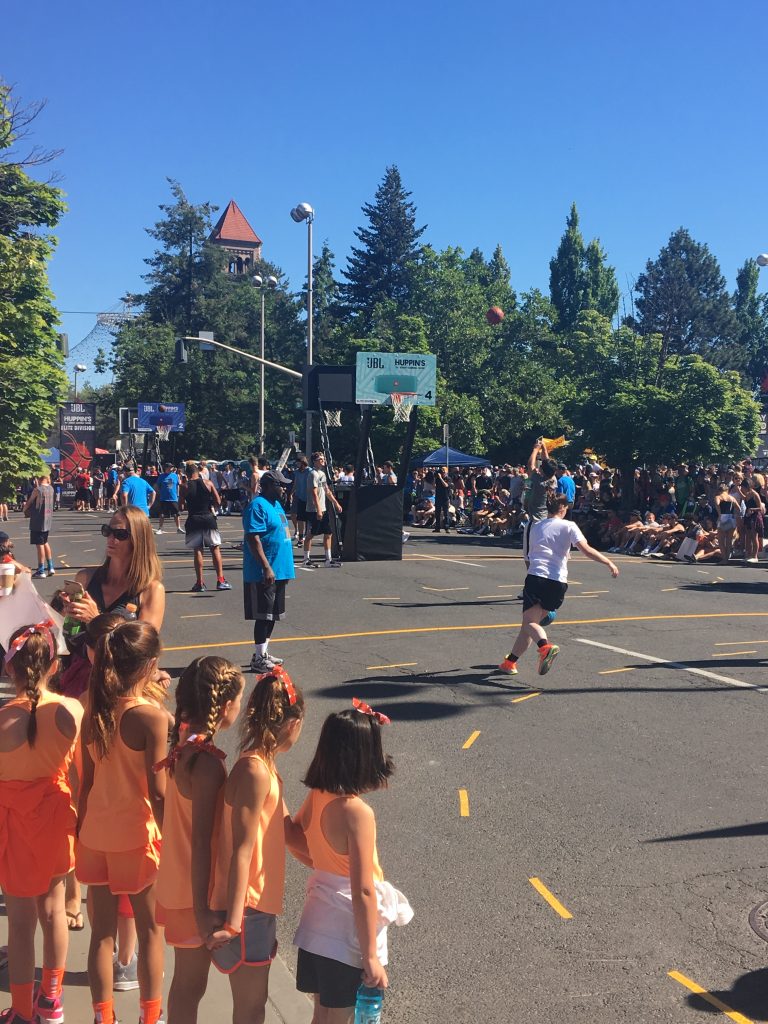 On the next play, JR’s man sprinted up the right wing, hoping to break free for a shot. But JR jumped the passing lane and tipped the ball out of bounds. The other team would still have another chance to score, but if Desert Horse could steal the ball or at the very least force them to take a one-point shot, they’d be in position to win. Now JR’s man set up on the other side of the court, and again he shook free. This time, JR found himself trailing a half-step behind, which gave his man enough time and space to launch a high-arcing two-point shot. JR sprinted out to contest the shot, lunging at his defender. All he needed was to nick the ball with his fingertips, anything to send it slightly off course. But he was too late. He’d jumped with such force that he’d lost his balance in the air and came crashing down to the asphalt on all fours. I locked my eyes on JR, who was looking over his shoulder, tracking the ball in flight.
On the next play, JR’s man sprinted up the right wing, hoping to break free for a shot. But JR jumped the passing lane and tipped the ball out of bounds. The other team would still have another chance to score, but if Desert Horse could steal the ball or at the very least force them to take a one-point shot, they’d be in position to win. Now JR’s man set up on the other side of the court, and again he shook free. This time, JR found himself trailing a half-step behind, which gave his man enough time and space to launch a high-arcing two-point shot. JR sprinted out to contest the shot, lunging at his defender. All he needed was to nick the ball with his fingertips, anything to send it slightly off course. But he was too late. He’d jumped with such force that he’d lost his balance in the air and came crashing down to the asphalt on all fours. I locked my eyes on JR, who was looking over his shoulder, tracking the ball in flight.
The shot went in. JR picked himself off the street and congratulated the other team. He threw no tantrum. He grabbed his weathered backpack and slipped through the crowd, still packed densely around the court. He had no plans of staying to watch the championship game, which would be played in less than an hour. He just kept walking, past the remnants of the weekend—littered water bottles, loose chunks of styrofoam, and apple cores—to his minivan with the mattress in back, and hopped on I-90, heading east.![]() George Plimpton’s Paper Lion, in which he joins the NFL’s Detroit Lions for training camp and writes about being their “last string quarterback,” ends on a peculiar note. As Plimpton leaves the Lions’ practice facility for the final time, he walks up through a pine grove and comes across two women playing tennis. They’re amateurs, in both senses of the word, “awkward at it, using their game for gossip.” They can barely keep the ball in play. They don’t keep score. They chat extensively about nothing. Then a sound erupts from one of the Lions’ players off in the distance on the practice field, a “despairing croak, as if he had run too far, or belted the tackling dummies too hard, or his uniform felt soggy and itchy from sweat.” The women pause their game and try to make sense of the sound.
George Plimpton’s Paper Lion, in which he joins the NFL’s Detroit Lions for training camp and writes about being their “last string quarterback,” ends on a peculiar note. As Plimpton leaves the Lions’ practice facility for the final time, he walks up through a pine grove and comes across two women playing tennis. They’re amateurs, in both senses of the word, “awkward at it, using their game for gossip.” They can barely keep the ball in play. They don’t keep score. They chat extensively about nothing. Then a sound erupts from one of the Lions’ players off in the distance on the practice field, a “despairing croak, as if he had run too far, or belted the tackling dummies too hard, or his uniform felt soggy and itchy from sweat.” The women pause their game and try to make sense of the sound.
I thought a lot about the passage at Hoopfest, where the line between professional and amateur blurred. There’s comfort to be found in that grove among the “hum of insect [rising] up out of the hot pines.” There, one can “[dismiss] the past in a quick rush of breath.” But I can also see how someone might read that scene as purgatorial—a glimpse into the daunting prospect of a life in which there is no triumphant victor or crushing defeat spawning a shot at redemption—and wonder, as one of the women asks, “‘Who’s serving? Who’s serving? I’ll serve!’” and then “[throws] the ball so high in the air that she [has] to maneuver under it, her racquet poised,” why even swing the racquet? I wanted to know why JR had to keep score in the pine grove. I wanted him to decode the hyper-competitive athlete’s mindset for me, to make it something more than some distant sound, one that I’d spent most of my life trying to discern.
Zack Camel approached me after the loss, crestfallen. I asked if we could chat for a few minutes, and he gave me a pained smile. We tacitly agreed to follow-up on the phone in a few weeks. Zack and JR hadn’t even talked about Hoopfest until two days before I called. The loss stunned them. “We were already looking at the championship [thinking] now, ‘this is how we’re going to do it,’” Zack told me. “Shit, then we get caught and we lose and everybody just can’t even believe that we lost.”
Surely no member of Desert Horse will agree with this, but shortly after Hoopfest, I wondered if losing wasn’t such a terrible outcome. The narrative practically spins itself for next year: an aging star returns for a shot at redemption, joined by his family and close friends. Their plan is to start all over again, to go for the four-peat, to chase history. Zack was confident the loss would motivate his brother. If Desert Horse can once again get to the point of winning a fourth-straight championship, JR Camel will be at least 47 years old. “It’s going to take a thousand days,” Zack said. “You know, that’s a long time when you think about it.”
